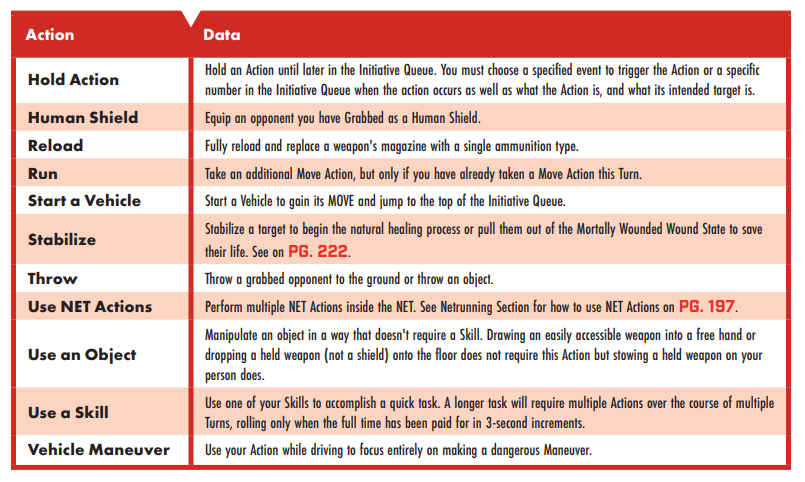Combat Basics
There are a few basic rules to this mental landscape.
First, if your Character can see something with the
naked eye or the scope of a weapon, you can interact
with it. If there's anything in the way, it's considered to
be blocked and you can't interact with it. If it's positioned forward of your shoulders, you can face it and
possibly interact with it. Last, if it's within your reach (2
m/yds), you can also touch it; otherwise, you'll need
to use a longer tool, weapon, or some other method
to extend your reach.
That brings us to the subject of measurement. In
Cyberpunk RED, we measure everything in both
meters or yards (and treat them interchangeably;
the difference is only about 2 inches). One reason
we do this is that it means we don't have to change
measurements around between Metric and English
systems. It also corresponds pretty well to a generic
6-foot Character.
If you are using a grid and miniatures, each 1-inch
square corresponds to 2 meters/yards
Distance and Movement
As a rule, there are three scales of movement used in Cyberpunk RED. ▶ Narrative Movement ◀ The first scale is narrative movement. This means movement that is described in real-world terms as part of the narrative of a story. For example, cars move at miles or kilometers per hour, walking is measured in similar, but smaller, distances. For most game purposes, we classify these types of movement by categories. Below, you can find the movement categories for the average human. In the Vehicle Combat section you can find the narrative speeds of the various vehicles. ▶ Figurative Movement ◀ The second scale is Figurative Movement: comparing one MOVE STAT to another MOVE STAT to see who is faster overall. This is best for simple sustained speed contests, like the outcome of a footrace. This is where you compare the Lamborghini to the Volkswagen; one has a higher MOVE STAT than the other, and this is used as a basis of comparison. ▶ Literal Movement ◀ Finally, there's Literal Movement: a measurement of actual distance, used in combat and when using miniatures. Every Turn, a Character gets a Move Action, which can only be used to move a number of m/yds equal to their MOVE x 2, or a number of squares equal to their MOVE, which can include moving diagonally.Time and Initiative
Cyberpunk RED uses two ways of measuring time. The first, Roleplaying Time, works just like it does in real life. The second, Combat Time, is far more exacting. Combat Time is divided into Turns, each of which takes approximately 3 seconds. The amount of time it takes each entity involved in the combat to take a Turn is a Round. Because Actions happen roughly simultaneously in game, one Round is also approximately 3 seconds long. ▶ Initiative ◀ But who gets to go first? For that, we need to determine Initiative; basically, a Character's place in "line" relative to everyone else doing something in the Turn. The "line" is what we call an Initiative Queue; a mental lineup of who goes when.When a combat starts, everyone rolls Initiative: Your Initiative Value = REF + 1d10All participants in the combat place themselves according to their Initiative result into the Initiative Queue in descending order from highest score to lowest score. Resolve ties by rolling again. Combat proceeds in Initiative Queue order, with each entity in the Initiative Queue getting a Turn. When the bottom is reached, the Initiative Queue is repeated from the top in the same order.
On Your Turn
Every Turn, a Character gets one Move Action and one Action. In this section we will describe the most common Actions. Many of those Actions will only happen during or directly after a combat.Your Turn = 1 Move Action + 1 Action Every Turn, a Character gets 1 Move Action and 1 Action
Move Action
Every Turn, a Character gets a Move Action, which can only be used to move a number of m/yds equal to their MOVE x 2, or a number of squares (if playing on a grid) equal to their MOVE, which can include moving diagonally. If you are playing on a grid, you cannot stop in between the squares. ▶ Prone ◀ When you are Prone, you can't use your Move Action until you use the Get Up Action. ▶ Split Movement and ROF ◀ Combat in Cyberpunk RED is fast-paced and fluid. Whenever you Move using your Move Action, you can take your Action in the middle of that Move Action, and then keep Moving afterwards. We call this Splitting, and it's not just for Move Actions. Some types of attacks are faster than others, capable of striking/ shooting twice with a single Attack Action. These are called 2 Rate of Fire Attacks (or 2 ROF). All attacks from 2 ROF sources can be "split" across a Move Action. You can move, shoot, move, shoot, move. You can even make a single attack from each of two different 2 ROF sources by "Splitting" your two attacks across the two of them, allowing them both to be used in a single Turn. So yes, you can use the Heavy Pistol in your left hand to take a shot down the hallway, then walk down that disgusting hallway to stab your victim with the machete in your right hand. Attacks from 1 ROF sources are slower, and take your whole Attack Action, but you can still split movement around them. ▶ Other Forms of Movement ◀ Swimming, Climbing, and Jumping with a running start all cost 2 m/yds of movement for every m/yd traveled or 2 squares for every 1 square. When jumping from standing you can clear half the distance that you could with a running start. See Taking Damage later in this section (pg. 180) for more on falling and drowning.Remove these ads. Join the Worldbuilders Guild












Comments